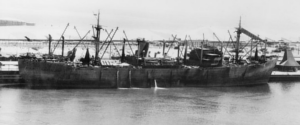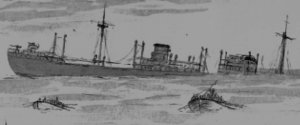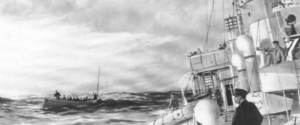
The MS Abbekerk was a 7900 brt freighter of the Verenigde Nederlandse Scheepvaartmaatschappij VNS. With a crew of 50, accomodation for 12 passengers, two powerful diesel-engines and two propellers, she was a fast ship designed for the Holland – Australia line. Abbekerk was build in Danzig and completed in 1939. Ironically Danzig was the pinnacle of the start of the Second World War and only months after Abbekerk was finished the Germans occupied it and started producing of 94 U-boats on the same shipyard.
Abbekerk was in Abadan or Madras when Holland entered the war and started sailing for the allies immediately. She returned to Liverpool and later sailed to Londen. She was attacked by airplane(s) when she passed Hull by night. Although they never saw the plane, a bomb exploded only 30 meters behind the ship and by daylight the crew found bullets and holes in the ship.
Later she docked in Albert Dock in London. Unfortunately this was during the last phase of the Battle of Britain, in which the London Docks became the primary target of the German Luftwaffe. On September 8 1940 Abbekerk was hit by two bombs and sunk. She was quickly refloated but it took half a year to get her seaworthy again.
Being a very fast ship for its time (17 knots officially, but according to my father she was capable of over 20 knots and did 22 knots on seatrials) , Abbekerk mostly sailed alone relying on her speed to outrun the enemy submarines or took part in fast (troop)convoys. In 1941 she was armed with only two Lewis guns and a hand grenade throwing device the crew didn’t dare to use. She sailed in convoy to Durban and then continued alone to the Dutch East Indies, the Pacific, the Panama Canal, Jamaica and finally back to England (from this journey I only have limited information found yet).
Now she got armed with a 10 cm anti submarine canon and two Bofors anti aircraft guns and – very rare for a freighter – 6 depthcharges on a rail. In the winter of 1941/42 she was in one of the convoys desperately trying to strengthen the defences of Singapore against the Japanese. With a cargo of mainly ammunition, anti aircraft guns and 12 Hurricane fighters she sailed in the heavily escorted convoy DM.01 to Singapore. The crew even put anti aircraft guns from her cargo on deck as extra defence.
By the time the convoy arrived in Singapore the harbour was under constant attack. The Hurricanes and guns were quickly unloaded but harbour workers simply refused to unload the ammunition. The crew then unloaded part of it but after a couple of days no empty barges came anymore. By that time there were no bombers left in Singapore for the heavy bombs Abbekerk was carrying. Abbekerk then sailed alone to Oosthaven were she helped to destroy (sink) barges and unloaded some more cargo. But she also had to unload all her bofors guns and the English troops that manned it.
Just before the Japanese invasion she sailed alone to Tjilitjap where she became a evacuation ship for troops and refugees. With over 1500 evacuees on board she sailed from Tjilitjap February 27 and was one of the lucky ships to arrive safely, despite being attacked by a Japanese aircraft.
From Fremantle she sailed independent with timber to Abadan. Near Colombo she wrongly identified a English reconaisance plane for the enemy and wouned the observer with her new Oerlikon guns. She continued to Durban and had a nightly head-on near collision with a unidentified submarine. From Durban to the Caribbean and, still lucky, crossed the Atlantic alone in the most successful period of the German Uboats. By now she had been in tropical waters for almost two years and her biggest defence against Uboats – her speed – was now seriously compromised by the algae on her hull. Her skipper tried to get her a place in a dry dock in Port of Spain but unfortunately there was no space.
On her way to England heavily loaded with sugar she failed to outrun a Uboat spotted half a day earlier and she was hit by a torpedo from U604 a quarter to midnight on August 24 1942. By the time a second torpedo hit the crew had abandoned ship in two lifeboats. 60 of the crew and passengers were picked up three days later by a the corvette Wallflower and later transfered to ships in the convoy Wallflower was escorting. Two of her crew didn’t survive her sinking.
Technical information:
Callsign: PDAD (not PCBK)
Compagny: VNS, Verenigde Nederlandse Scheepvaart Mij – Rotterdam
Year build: 1939
Launched: February 1939
Shipyard build: F.Schichau, Danzig (Dl.)(no. 1419)
BRT: 7.906
DWT: 11.604
L x B x H: 150,5 x 19,29 x 9,51/11,70 metre
Engines: 2 x 2TE 10 cilinder Sulzer, 2 propellors
Power: 11.000 Hp at 125 rpm
Speed: 17 Knots (according to my dad she did over 20 knots)
Crew: 52
Sisterships:
- Sister: MS Arendskerk, build in 1938 at the same shipyard and sunk by U44 Januari 15, 1940 while Holland was still neutral. (All of her crew were picked up by the Poelau Bras. She was the first ship the VNS lost in WOII.)
- Close sister: MS Amerskerk, build in Rotterdam 1942 and entered service for the Germans named Coburg. Sunk north of Holland by allied air-attack in 1944.
- After the war 2 ships were build that can still be considered close sister ships: MS Arendskerk and MS Annenkerk (they look very much alike the pre-war ships: main visible differences: funnel is closer to the front of the post-war ships, the bridge building is larger and the air-intakes/loading masts have different topforms)
Ships named “Abbekerk”:
- Abbekerk (1698) sailing ship of the VOC (Verenigde Oostindische Compagnie)
- Abbekerk (1734) sailing ship of the VOC (Verenigde Oostindische Compagnie)
- Abbekerk (1772) sailing ship of the VOC (Verenigde Oostindische Compagnie)
- SS Abbekerk (1912 -1932) steam (cargo) ship of the VNS (Verenigde Nederlandse Scheepvaartmaatschappij)
- MS Abbekerk (1939 – 1942) motor (cargo) ship. This is the Abbekerk of this website (see also: click here)
- SS Abbekerk (1946 – 1972) steamturbine (cargo) ship (Type C3) of the VNS (Verenigde Nederlandse Scheepvaartmaatschappij)










My Stepfather, Jan Steven Roes (we called him Pop), was in the Dutch Naval Air Force and was stationed on The Netherlands Naval Air Base Morokrembangan near Surabaya, Java. Specifically, Pop probably worked at the Seaplane part of the base as he was a flying boat mechanic. Pop was wounded by shrapnel during a Japanese air attack. Although he never said, I assume he would have been evacuated from Tjilitjap, and was graciously spared in all that unlike so many others. I ask if any readers here might have any knowledge of Jan Steven Roes from this time in his life. Or, any idea where I might find such information. Many thanks.
Hi,
My father James Lewis Hunt was one of the men who evacuated on the Abbekerk. He was an American who was doing road construction in Malaya when war broke out. He evacuated to Singapore and left Singapore on Feb 9, 1942. He made it to Batavia on Feb 13 and enlisted the next day with the American detachment of ABDA forces. I am presently working on a non-fiction article to publish about the other American civilians who also enlisted and evacuated with him. I’ll keep you posted when I finish the article (should be relatively soon–I have identified all 31 civilians who were appointed officers in the U.S. Army.)
Just in case you have not seen it: Have you heard of a book called “My Fighting Congregation” by Chaplain William C. Taggart, published by Doubleday, New York, 1943? Chaplain Taggart describes his unit’s escape on the Abbekerk.
My uncle, the late Fritz Andreas, was machinist onboard the raider Atlantis.
When it was sunk it was disguised as Abbekerk.
Regards
Hello
My father was an officer on HMS Wallflower. I have in my office a brass compass binnacle and the compass which came from a lifeboat they found during the war. It may be from MS Abbekerk, I’m afraid we have no way of knowing now but I remember him saying he went onto this lifeboat quickly to get a souvenir before they sunk it. I can send you photos of the compass if you like
Best regards
Aidan Tuckett
Hi Kyle
I think I can help you some, but I dont have youre email adress.
Can you please email me: peter@peterenhanneke.nl
Peter
hope you see this because this project is worth half of my grade.
i am making a project about a boat named ss hato but because i can not find it i an going to do it on this boat. iF YOU FIND ANY INSIDE LOOK OF THE boat could you post it on the website before december9. Also if you have any special features could you also post it. Kyle
Hi Niels,
Good question. What exacly was the reason to name her Abbekerk I don’t know.
The VNS (Verenigde Nederlandse Scheepvaarmaatschappij) named most of her bigger cargo ships after places in Holland that end on -kerk (Which means church in Dutch).
examples: Bovenkerk, Serooskerk, Maaskerk, Aagtekerk, Heemskerk, Amstelkerk, Hoogkerk etc. (I’m not sure if these places really all do exist:-)
The passenger ship often named -fontein (I guess thats because VNS had several lines to Africa and fontein (fountain) is a common ending for the names of towns in South Africa). Examples: Rietfontein, Boschfontein, Oranjefontein etc.
After the war, some ships that sailed lines to west Africa were often called -kust (meaning Coast), like Dahomeykust and Ivoorkust, but -kerk was by far the most used ending.
Ship names were often re-used after a ship was sold or scrapped. Or sunk.
On the VNS website you can find a lot of information on the ships. (VNS is now part of Nedloyd)
Peter
Hello,
why did they called it ‘Abbekerk’?
I live in Abbekerk (N-H) in the Netherlands.
Best regards,